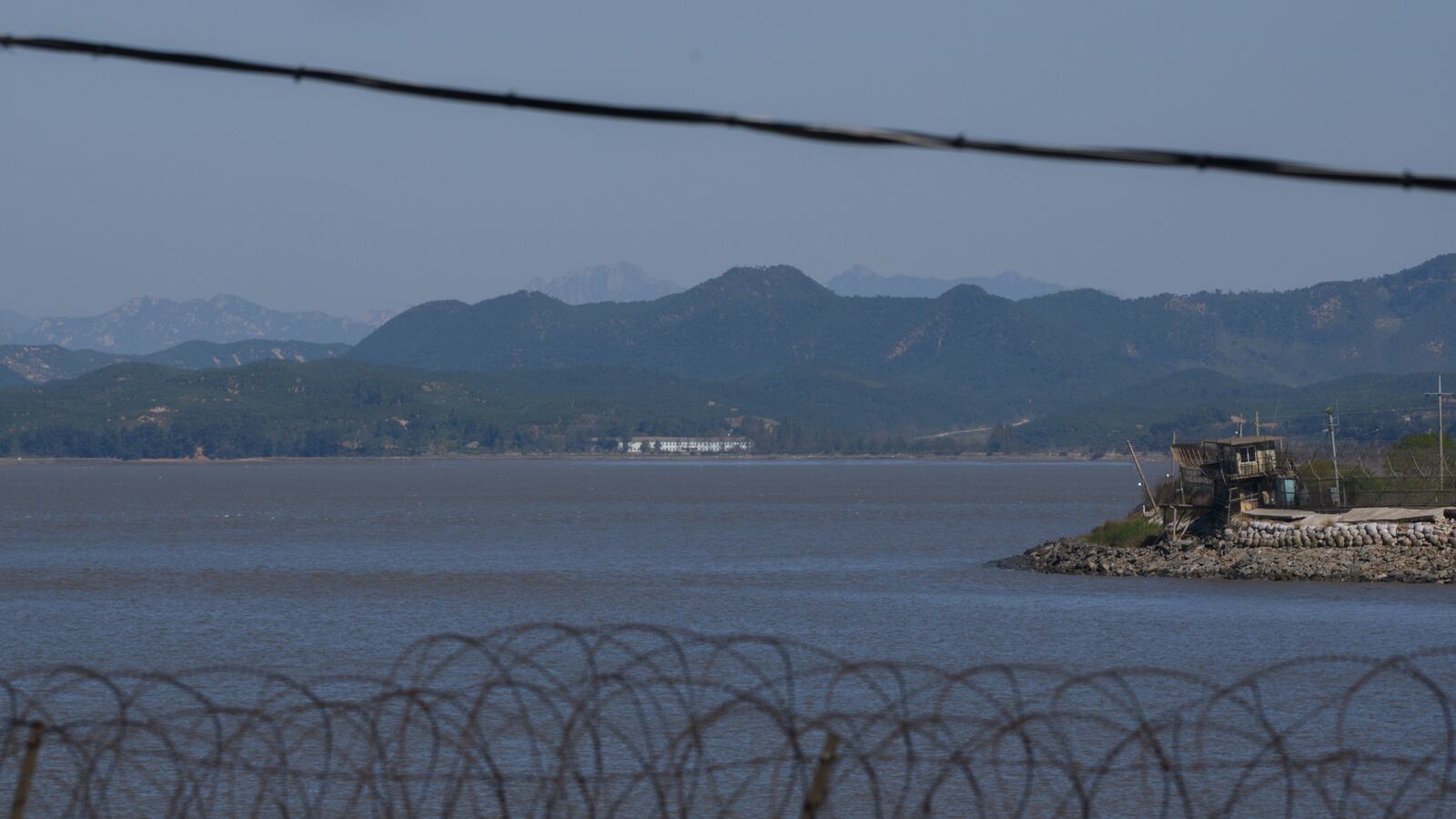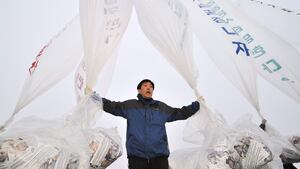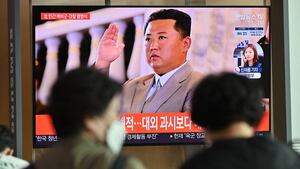Talk about double jeopardy.
It was one thing for a young North Korean man to jump over the tall barbed-wire fences of the heavily guarded demilitarized zone (DMZ) between the two Koreas and defect to the South. And it was quite another to do it the other way around.
This Saturday, according to embarrassed South Korean officials, the unidentified man, who is reportedly in his 30s, re-defected. That is, he made it over the fences of the four-kilometer-wide DMZ and back into North Korea. Having defected to the South back in November 2020, he evidently decided he didn’t like his lowly job for a cleaning service in the South and wanted to go back home the way he came.
Considering the height of the fencing, the man either had to climb up and over the wire curled at the top or take a running leap or even pole-vault. While under interrogation after his first defection to the South, he reportedly described himself as a gymnast in North Korea—light, slim and in good physical shape. His success in getting up and over the barriers, not once, but twice would suggest he’s fit enough to have dared crossing from North to South and back again.
The case has the South Korean defense ministry wondering how it could have been so easy for the man to escape detection by surveillance gear on the southern side of the line. And how then could he have slipped through and around mine fields and escaped South Korean troops scrutinizing any signs of movement in the crags and valleys on the eastern end of the DMZ, the scene of some of the Korean War’s bloodiest battles?
While interrogating the South Korean army officers responsible for that particular patch of desolate turf, an anonymous South Korean official dismissed speculation that he was either an embittered South Korean army turncoat or a North Korean spy. The official told Korean journalists that the man “was recognized to be the same as the defector” after reviewing surveillance footage that captured a glimpse of his movements.
The success of the man in evading detection as he infiltrated the DMZ and then crossed the line into the North places him in a unique category. “Never heard of someone going both ways through the DMZ since the war except for spies/agents,” Steve Tharp, who’s made a career watching North Korea as an army officer and civilian official with the U.S. command, told The Daily Beast. “If he isn't an agent, it must be a first.”
It’s not all that unusual for defectors from North Korea, many of them facing discrimination, loneliness and near-poverty in the South, to regret leaving the North, but so far only about 30 of the 33,000 or so who’ve made it to the South have then made it back.
The vast majority of defectors have escaped North Korea by crossing either the Yalu or Tumen River into China, evading capture by the Chinese, who would return them to cruel fates in North Korea, and making their way either to Mongolia or into Thailand, Laos or Vietnam. Re-defectors, as they are sometimes called, generally go back via China.
Some of those who’ve opted to return have appeared on North Korean TV saying how awful life was in the South, how much they had wanted to return to their families and, of course, how grateful they were to North Korean leader Kim Jong Un for the benefits and privileges of life in the North. For this man, though, the immediate challenge after he stepped across the line would have been to avoid getting shot on sight by North Korean soldiers dug in close to their side of the DMZ.
North Korea acknowledged receiving messages from the South asking about the man but did not say if he’d been picked up dead or alive. Chances for survival, however, were not good.
“I think it was likely a fatal mistake for the defector as the KPA (Korean People’s Army) are not receptive of defectors due to COVID19 concerns,” Tharp told the Daily Beast. “I assume that the defector is dead and has been burned or otherwise disposed of by now.”
Tharp doubted the North Koreans would acknowledge having killed him, as they did in the case of a South Korean fisheries official who was shot and killed while floating in the Yellow Sea in September 2020.
Miraculously, however, this alleged gymnast was able to weave around mines in place on the southern side of the DMZ since the Korean War ended with a truce in July 1953.
“There are so many mines unaccounted for over the decades,” said David Maxwell, a retired U.S. army colonel. “It is very dangerous to walk in the DMZ. It is not like in the movies and someone provides a hand sketch to follow at night.”
Maxwell, who did five tours in South Korea in the special forces, told The Daily Beast, “Known and marked minefields can be avoided if you have the knowledge and experience” but emphasized, “Many unmarked mines make it very dangerous.”
But how could the man have gotten past the South Koreans just below their side of the DMZ?
“The breakdown was not in the DMZ,” said Maxwell, now with the Foundation for Defense of Democracies. “It was at the South Barrier fence (SBF) on the southern edge of the DMZ. There must have been a breakdown in observation, patrolling, and the high SBF to allow this person to enter the DMZ.”
The problem could well be related to both politics and technology. The government of South Korea’s liberal President Moon Jae-in, looking for dialog with the North, “may be reluctant to appear too aggressive,” said Maxwell. “They rely on technology which has been proven time and again to be insufficient whether it is the DMZ or any nation’s border.”
And, he said, “Once in the DMZ there is no fence from two kilometers south of the military demarcation line until you reach the north’s territory.” The man, having made it past the barrier fence, “could make it across the DMZ and be lucky he did not step on a mine anywhere as there are so many within the DMZ.”
Politics was clearly an all-important factor, in the view of Shim Jae-hoon, who’s been analyzing North Korea as a journalist for years.
“The main issue is lax discipline, especially under this regime,” said Shim. “Remember: this incident happened during New Year holidays. The company commander in charge apparently relaxed security. Such lapses occurred rarely under the conservative government leadership.”








